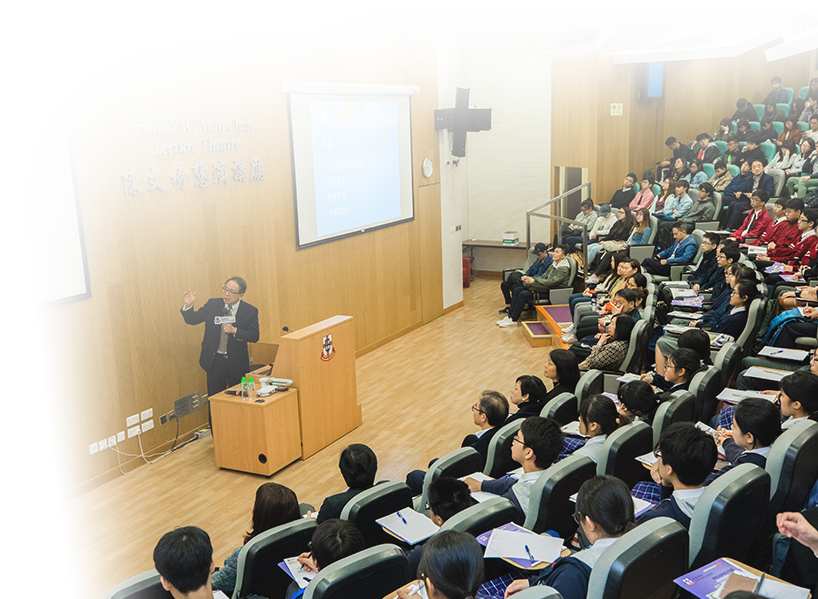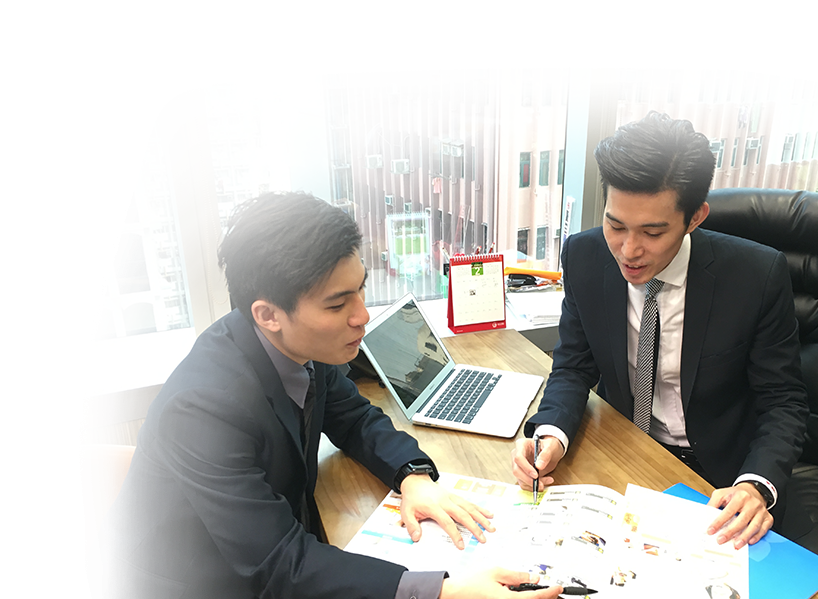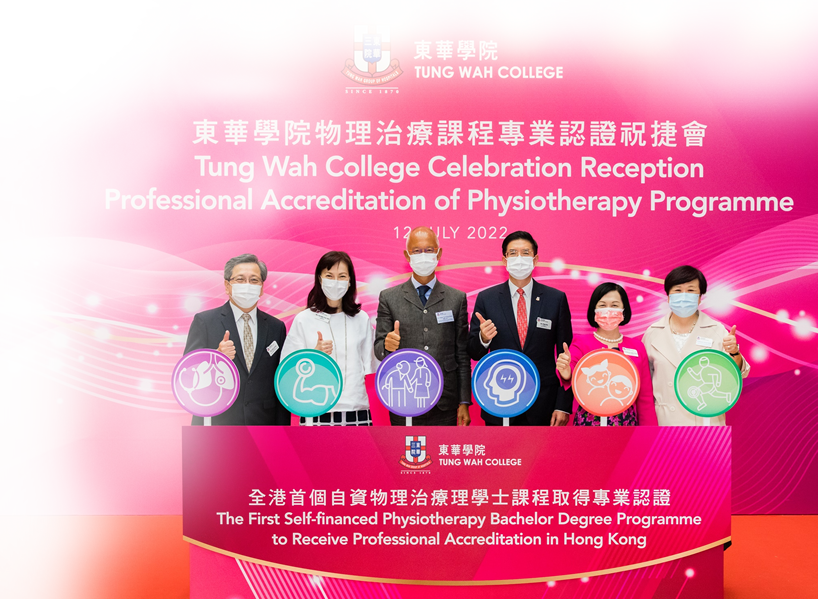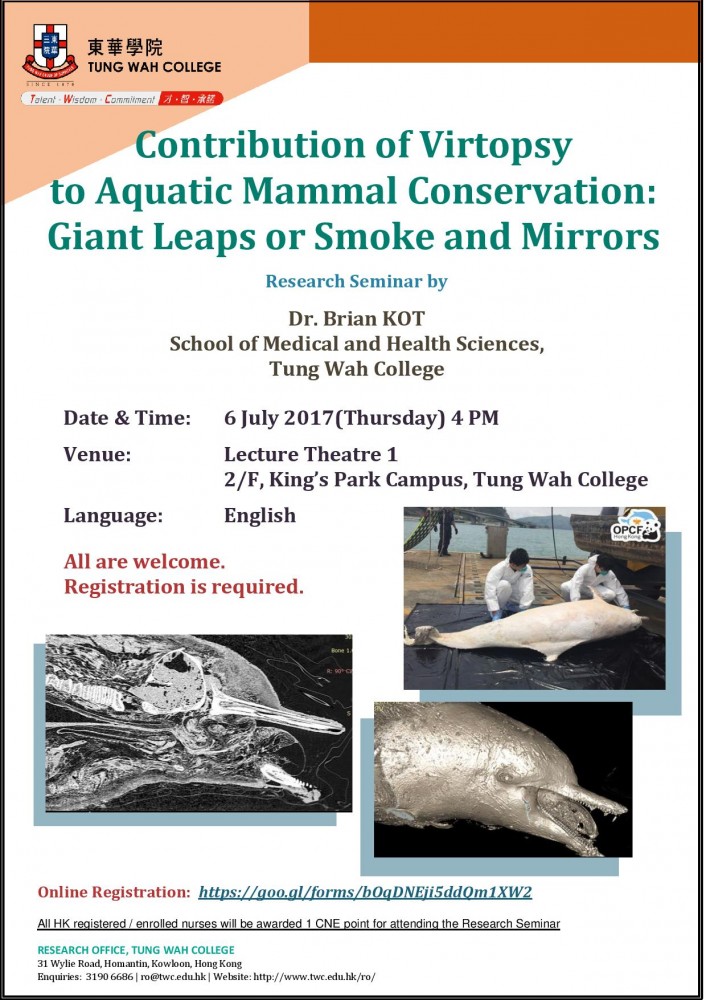

课程
-
学士学位课程
-
副学位课程文凭课程
 Contribution of Virtopsy to Aquatic Mammal Conservation: Giant Leaps or Smoke and Mirrors
Contribution of Virtopsy to Aquatic Mammal Conservation: Giant Leaps or Smoke and MirrorsTopic: Contribution of Virtopsy to Aquatic Mammal Conservation:Giant Leaps or Smoke and Mirrors Date & Time: 6 July 2017(Thursday) 4 PM Venue: Lecture Theatre 1, 2/F, King’s Park Campus, Tung Wah College Speaker: Dr. Brian KOT,School of Medical and Health Sciences,Tung Wah College Language: English Registration: Now open for free registration at https://goo.gl/forms/bOqDNEji5ddQm1XW2 Remarks: All HK registered /enrolled nurses will be awarded 1 CNE point for attending the Research SeminarAbout Dr. Brian KOT Dr. Brian Chin-wing Kot, is a registered diagnostic radiographer and ultrasonographer, obtained his BSc of in Radiography, and subsequently his PhD in Diagnostic Imaging from the Hong Kong Polytechnic University in 2005 and 2010 respectively. He furthered his study on postmortem radiology with Prof. Michael Thali and his team at Institute of Forensic Medicine, University of Zurich in 2016 and rewarded a certificate in virtopsy.Brian is currently an Assistant Professor in School of Medical and Health Sciences, Tung Wah College, with particular interest on public health and conservation medicine in aquatic animals. His team is the first worldwide researchers to successfully apply virtopsy routinely in stranded cetaceans. He has received a competitive research funding in 2014 from the Hong Kong Research Grants Council (RGC), on the topic of routine applicability of postmortem CT and MRI in stranded cetaceans. His RGC study aimed to supplement conventional necropsy procedures for better insight into their causes of death, pathological and biological profile investigation, which eventually provide precise conservation measures for these cetacean populations. Presentation Abstract BACKGROUND Virtopsy on the stranded cetaceans is an established technique performed on most carcasses found in the HK waters and Yangtze River over the last 3 years. It is used primarily to assist veterinarians and scientists in determining cause of death, but is also invaluable to investigate the life history of stranded individuals.AIMS AND OBJECTIVES This study aimed to evaluate the practicality of virtopsy techniques in stranded cetaceans and compared the findings obtained by conventional necropsy. METHODS Between March 2014 and April 2017, a total of 161 cetacean deaths were confirmed in the Hong Kong waters, Bohai Sea and Yangtze River. Whole body virtopsy of 105 carcasses were performed and analyzed for pathological findings. Five cetacean species, Sousa chinensis and Neophocaena phocaenoides (46 males, 53 females, 6 unknown sex; calf to adult; 50-272.5 cm in length), were included, with the carcass code ranging from 2-5. Postmortem computed tomography (PMCT) was performed on a 16-slice multi-detector row Toshiba Alexion™ CT system or a 64-slice Somatom Definition Dual Energy CT system. Postmortem magnetic resonance imaging (PMMRI) examination of brain, thorax and spine was performed on a 0.25T Esaote Vet MRI Grande scanner or a 3.0T Siemens MRI Magneton Trio scanner. Post processing was performed with the built-in software and/or TeraRecon Aquarius workstation. Radiological findings were compared with subsequent necropsy findings. RESULTS & DISCUSSION Most of the radiological findings, pertaining to head and neck, heart and vascular, thorax, abdomen, vertebral column and pectoral limbs, corresponded to necroscopic findings. PMCT was useful in diagnosing fatal hemorrhage, organ herniation, and pathological gas collection, as well as determining the number, shapes and characteristics of the fractures sites and the direction of external force. PMMRI was effective in evaluating soft tissue lesions, musculoskeletal injuries, integrity of spinal cord and brain herniation. Radiological assessment of the degree of epiphyseal fusion/ossification at postcranial skeleton allowed individual age-at-death estimation, supplementing the data obtained by dental growth layer group pattern. CONCLUSION This study demonstrated virtopsy is a powerful tool, providing non-invasive and objective measurements to supplement the necroscopic findings for cetacean pathological and biological profile investigation, which potentially aids marine conservation planning and management. Should you have any enquiries, please contact Ms. Candy Hui at 3190 6686 or email to us at [email protected].
研讨会 / 工作坊最新消息及活动
-


















